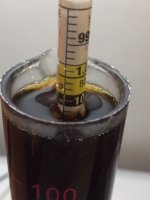I wanted to make a Baltic Porter to age for next winter and chose Wyeast 2206 Bavarian Lager to work with. In building my recipe, I was more concerned about the grist bill and admittedly not as much about the yeast apart from using the proper type. On brew day I was set with all my ingredients including two packs of Wyeast 2206. In hindsight, I wasn't thinking. This was using lager yeast, pitching cold, and high gravity at that. Two smack packs just ain't gonna cut it. I should have made a starter, but I was out of DME and got away with it before.
I brewed my Baltic Porter, pitched the yeast and got activity on the airlock in about 18 hours. So far, so good. The fermentation was going fine, or so I though. About eight days into it, the airlock noticeable slowed (a bubble every 9 seconds to a bubble every 20 seconds), so I started I increased the temperature slowly for a D-rest. The bubbling on the airlock went slower...and slower...and slower. It took three weeks for it to stop bubbling.
I checked the gravity and then checked it again a few days later. If you rounded up, it was right at the bottom of the indicated attenuation range. I used Munich as a base and also Amber, Caramunich and Carafa III, so this seemed right to me. I thought it was done. Then, I cleaned/sanitized the bottles and added the priming sugar and bottled. I tried the bottles at one week, two weeks, three weeks and noticed them getting progressively more carbonated. This was good, but week 3 was a bit more than intended.
On week 5, I decided to try another since (1) they tasted wonderful, (2) I had a lot of bottles, (3) I was a bit concerned about the carbonation. I popped one in the fridge and opened it a couple hours later.
BOOM! Beer all over the place. Got books, my keyboard, three walls and nearly hit the ceiling. I was stunned with a stupid look on my face. It took a day and a half to clean-up, but could have been worse. I use swing top bottles and have been relieving the pressure before putting them in the fridge. There were about 30 of them and this took time after an initial confrontation with PTSD.
I also gave a couple to a friend, who drank one and saved the other. Told him the story and the attached photo he sent me after he opened one of the bottles. The long and short of it is that the yeast stalled at the worst possible point.
I swear to God, Jesus, and cute little baby Jesus, that I will take the yeast pitch rate seriously from this point forward!
I brewed my Baltic Porter, pitched the yeast and got activity on the airlock in about 18 hours. So far, so good. The fermentation was going fine, or so I though. About eight days into it, the airlock noticeable slowed (a bubble every 9 seconds to a bubble every 20 seconds), so I started I increased the temperature slowly for a D-rest. The bubbling on the airlock went slower...and slower...and slower. It took three weeks for it to stop bubbling.
I checked the gravity and then checked it again a few days later. If you rounded up, it was right at the bottom of the indicated attenuation range. I used Munich as a base and also Amber, Caramunich and Carafa III, so this seemed right to me. I thought it was done. Then, I cleaned/sanitized the bottles and added the priming sugar and bottled. I tried the bottles at one week, two weeks, three weeks and noticed them getting progressively more carbonated. This was good, but week 3 was a bit more than intended.
On week 5, I decided to try another since (1) they tasted wonderful, (2) I had a lot of bottles, (3) I was a bit concerned about the carbonation. I popped one in the fridge and opened it a couple hours later.
BOOM! Beer all over the place. Got books, my keyboard, three walls and nearly hit the ceiling. I was stunned with a stupid look on my face. It took a day and a half to clean-up, but could have been worse. I use swing top bottles and have been relieving the pressure before putting them in the fridge. There were about 30 of them and this took time after an initial confrontation with PTSD.
I also gave a couple to a friend, who drank one and saved the other. Told him the story and the attached photo he sent me after he opened one of the bottles. The long and short of it is that the yeast stalled at the worst possible point.
I swear to God, Jesus, and cute little baby Jesus, that I will take the yeast pitch rate seriously from this point forward!
Attachments
Last edited:











































![Craft A Brew - Safale S-04 Dry Yeast - Fermentis - English Ale Dry Yeast - For English and American Ales and Hard Apple Ciders - Ingredients for Home Brewing - Beer Making Supplies - [1 Pack]](https://m.media-amazon.com/images/I/41fVGNh6JfL._SL500_.jpg)















